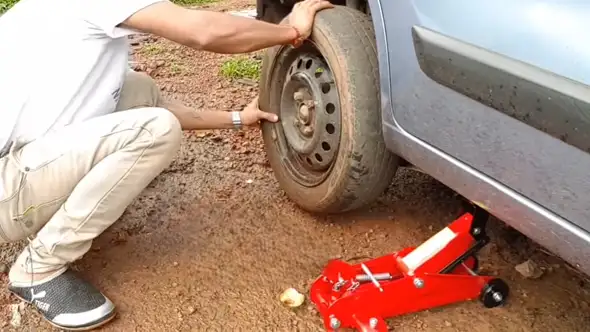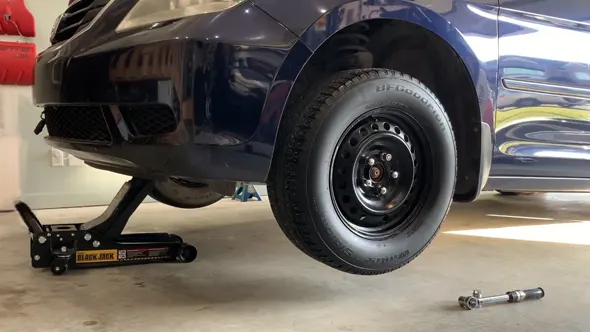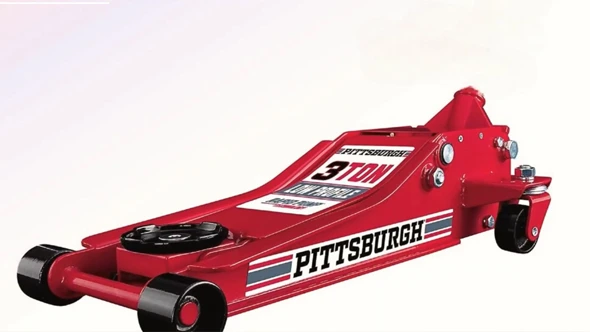Last Updated on March 11, 2023
Floor jacks are one of the most useful pieces of equipment for anyone who owns a car. When you’re working on a car and need a floor jack, they allow you to quickly and easily raise your vehicle up off the ground, making it much easier to work on.
Most floor jacks have a handle that is used to operate the jack. This handle is important, as it is what allows you to control the jack and raise or lower your vehicle as needed. Also, the handle helps you lift and move the jack. But what if the handle is broken or missing?
Releasing a floor jack without a handle can be a bit tricky, but it is certainly possible. Continue reading if you want to learn how to release the floor jack without a handle.
How to Release Floor Jack Without Handle: 5 Steps

Releasing the pressure on a floor jack is a relatively simple process. But the problem comes when you don’t have the handle to operate the jack. Depending on the situation, you may also need to remove the handle to work on the car. If this happens, you might wonder what to do without a handle. It’s not as difficult as you might think.
In this section, we will go over the steps in detail:
1. Remove the Jack’s Plate
To release a floor jack without the handle, you must first remove the jack’s plate. Generally, floor jacks have a metal tool plate that’s attached to the jack with screws. The first thing you will need to do is unscrew them all with a screwdriver. Once the screws are removed, the plate can be lifted off of the jack.
Some plates are hard to remove, as the plate is usually tight against the body of the jack. With patience and persistence, you should be able to get it off. Make sure not to damage the plate when removing it. Reattaching the handle later on will require the plate, which is an essential part of the car jack.
2. Find the Pressure Relief Valve
After you have successfully removed the plate, locate the pressure relief valve. The pressure relief valve is responsible for regulating the amount of pressure in the system. If the pressure in the system gets too high, it can cause the floor jack to malfunction. To find the pressure relief valve, you must remove the plate covering it.
In most cases, the pressure relief valve will be located near the top of the floor jack. It is important to check your specific model for the exact location. Once you have found it, place the wrench or pliers around the valve and turn it clockwise until you hear a hissing sound.
This indicates that the air is released from the car jack and that it is safe to remove your car. Be careful when turning the release valve so that it does not bend and become permanently damaged. Ensure that you do not over-tighten the valve, as this can cause problems when you try to use the jack again.
3. Put the Jack’s Plate Back On
Now that you have released the pressure from the system, it is time to attach the jack’s plate again. Ensure that the plate is flush with the jack’s bottom. It is very important to ensure the plate is flush on the jack before you release the hydraulic pressure.
If the plate is not sitting flush, it could cause the hydraulic jack to become unbalanced and possibly tip over. Also, not keeping the plate flush could allow air to enter the system and cause the pressure to be released too quickly. Once you have made sure that the plate is sitting flush, turn the knob or lever to the ‘release’ position to let the pressure out.
4. Check the Jack for Any Leaks
Once the pressure in the system has been released, and the plate for the jack reattached, it is time to check the jack for leaks. One of the most important things to check before using a floor jack is for any leaks. If you see any oil or grease leaks, it’s important to fix them before continuing.
If you don’t fix the leaks, the hydraulic jack is likely to malfunction or even fail completely. To check for leaks, apply pressure to the jack by pumping the handle up and down. As you pump the car jack, look for any oil or grease leaks. If you see any, use a clean rag to wipe them away. Then took proper action to fix the leaks.
5. Put the Handle Back On
After you have checked the hydraulic jack for any leaks and made sure that it is functioning properly, it is time to put the handle back on. Putting the handle back on the floor jack is a pretty straightforward process. Still, there are a few things you need to keep in mind to ensure that it is done correctly.
To begin with, make sure the O-ring is properly seated. By doing so, you’ll be able to create a tight seal and prevent leaks. The handle should be aligned with the holes on the jack’s base. When you have the handle in place, insert the pin or screw that will hold it in place. The handle should now be securely fastened.
What Are the Risks of Releasing Floor Jacks Without Handles?

When using a floor jack, it is essential to ensure the handle is in place before releasing the pressure. The handle allows you to regulate the amount of pressure that is being applied to the object that you are lifting. Without the jack handle, the entire force of the jack would be released, which could cause serious damage or injury.
One of the most common accidents that occur with floor jacks is when the user tries to release the pressure without first replacing the jack handle. This can often result in the jack suddenly slipping out from under the load, which can cause serious injuries if anyone is in the way.
Another risk associated with floor jacks without handles is that they can become very tough to control once fully released. This can often lead to the jack bouncing around erratically, which can be dangerous if someone is nearby.
Therefore, before releasing the pressure from a floor jack, always check that the jack stand is in place. Also, ensure that nothing stands in the way of the jack slipping beneath the load and causing damage or injury. You should keep a safe distance from the jack while you release the pressure.
What Is the Correct Way to Use a Floor Jack Handle?
The floor jack handle is an important part of the mechanism that helps to raise and lower the heavy-lifting platform. It is operated by a ratchet-type system that is engaged by pulling on the handle. The handle can be attached to either side of the platform, depending on the user’s preference.
To engage the ratchet, the user must first pull on the handle to release the locking pin. Once the pin is released, the user can then start to wind the handle in either direction. The floor jack will start to raise or lower according to which way the handle is turned.
It is important to note that the floor jack must be properly secured before using it. If it is not properly secured, it could slip and cause serious injury. Once the desired height is reached, the user can engage the locking pin to prevent accidental lowering of the platform.
What’s the Point of a Handleless Floor Jack?

At first glance, a floor jack with no handle may seem like an oddity. Despite this, there are a few reasons why this type of jack can be useful. Without a jack handle, it may be easier to maneuver in tight spaces. It is also less likely to damage a vehicle or the jack itself if it hits something while in use.
The weight and transportation of floor jacks without handles are typically lighter, along with the ease of transporting them. As a result, there are several potential benefits to using a jack without handles. This type of jack will ultimately depend on the user’s preferences and specific needs.
